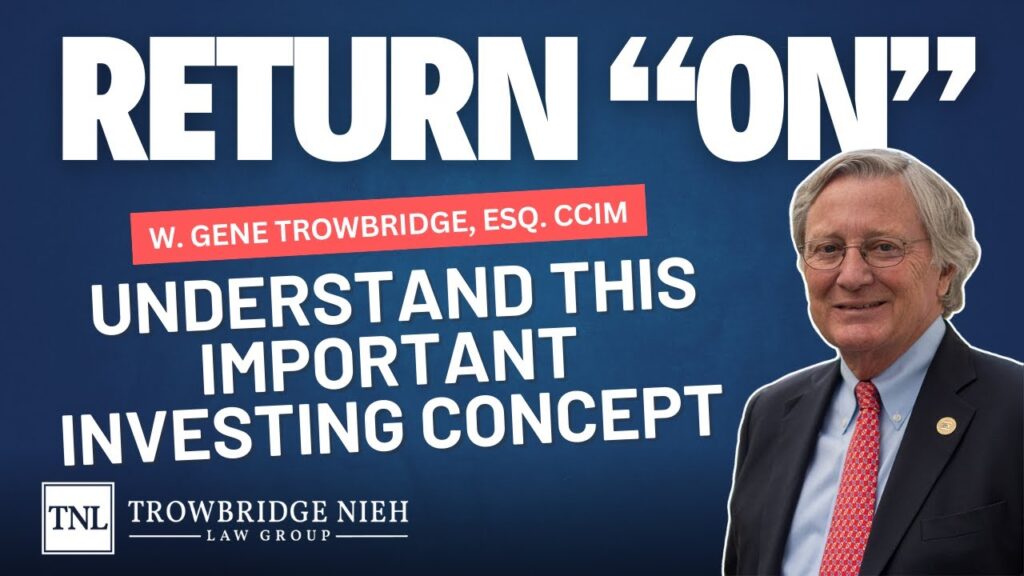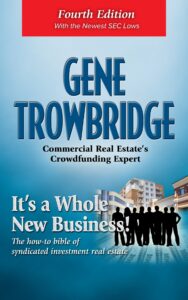Integration EXPLAINED!
In this episode of TBD with TLG, syndication and crowdfunding attorneys Jon Nieh and Gene Trowbridge discuss integration and how it may affect your securities offering.
Transcript
 | GT | - [Gene] So integration. How does it affect me in my securities offerings? Hi, I'm Gene Trowbridge and I'm here with my law partner, Jonathan Nich and we're on the Thursday Podcast of TBD with TLG. Our topics are always to be determined right before we go online. And it's the Trowbridge Law Group that is doing this. And the reason we're talking about Integration in Securities Offerings today is that Jonathan and I had a call this week and a call that we don't often get. It's been a long time since anyone has asked the questions about integration. So we thought we would cover it and covered in two main areas. First of all the issue of integration is an issue in Regulation D, Rule 502 and 502 is an important rule. The first thing it talks about is the laws on advertising and solicitation. And then it talks about the need for disclosure leading us to writing PPMs for your offerings. And another thing it talks about is when, two offerings or more are created in the situation where the the SEC would look at them and say, "That's really one offering. You're trying to split it up because you're doing something different." Just as an example. Let's say you put together an offering to take in investors so you could buy a piece of dirt. And then you did another offering to take in investors to build the building on the piece of dirt. And you went out and got one loan to build the building. Well, under certain circumstances, the SEC might come and say, "Well that's really one offering." And so the question would be, why did you do it like that? Did you do two offerings to take advantage of something or not? I don't know, but that would be an example of integration. The first thing we're gonna talk about is integration as how it relates to Rule 506 and rule 506 offerings. Can you do a 506 and then a 506 right after it? Or vice versa or at the same time? Well all that's gonna be governed by the rules on integration. And Jonathan's gonna talk about that right now. How you doing Jonathan? |
 | JN | - I'm doing well Gene, thanks for asking. |
 | GT | - Good. |
 | JN | - Yeah, so that is one of the issues or one of the scenarios where integration can become an issue, right? So the whole concept of integration with the reason why the SEC has this, it's not really rule but let's just say this is called rule, right? This integration rule is to prevent issuers, to prevent sponsors from doing one offering that's less restrictive. And then using that to get around the subsequent offering that's more restrictive, right? So in the example of doing a 506 and then doing a 506 offering, it's in regards to soliciting your offer, general solicitation. So remember under 506 you can advertise, you could generally solicit investors, but under 506 you can't, you cannot advertise at all. All of your investors have to have a substantive and preexisting relationship with the sponsor. So what can happen and what some issuers try to do is they'll do a 506 offering where they advertise to everybody. And then immediately after they'll do a 506 offering kind of utilizing that general solicitation from the 506 , but, they're pretending like, they already have a preexisting relationship with the people that they're bringing under 506 even though that they just met them through the advertisement under 506 . So the SEC, they say, "No, you can't do that. You're just trying to get around not being able to advertise under 506 . So we're gonna say, this is a single offering. We're gonna integrate it." And when they integrate it, the SEC imposes the more restrictive rules onto the offering and that scenario 506 is more restrictive. So that means that offering that you did that single offering, that they're saying that you did now has to abide by the 506 rules. And because you advertise, you violated the rules under 506 and now your exemption's completely blown. So that could potentially lead to criminal, civil liability. Yeah, this is something you should not be doing, but so the question then is, how do I make sure that, if I'm doing a 506 and then a 506 how do I make sure that it's not integrated? And the SEC has a safe harbor for that? So if you wait six months after your first offering closes to do your subsequent offering, you'll be fine. The two offerings won't be integrated, right. And I think that's what your client brought up, right Gene? When he called and asked about integration he brought up this six month rule. Like, "If I wait six months then I could do my second offering." But because he was trying to do two offerings at the same time, he was scared that he wasn't allowed to do that. But we'll talk about later, the factors that kinda go into whether those two offerings are integrated, but yes so there's that that six-month rule if you do a 506 and then wait six months. You should be fine to do your 506 . |
 | GT | - And that's what you and I always suggest to the clients who want to do a 506 . We tell them about this integration issue, whether we use the word integration or not? But we just tell them, you're gonna have to wait six months from when you close the offering under 506 until you can do your offering under 506 . Cause while you're at, while our clients are advertising for the 506 offering they can advertise to anyone. So they can find people that will end up in their database, but aren't accredited. And so now they want to use those people in the next offering, which would be a 506 . And that's actually one of the reasons we have newer syndicators coming to the market who would like to do a 506 is because it does give them the right to advertise and find new people and build their database. The more experienced syndicators that we have who have plenty of investors, don't find the need to advertise. So they just stick with the 506 . Isn't that your experience, Jonathan? |
 | JN | - Yeah, for the most part, if it works, why change it, right? |
 | GT | - Right, so that's the advice we give everyone and no one's gotten into trouble yet following that advice. So I'm proud of that. The call that I had this week did address the six-month rule, no question but it addressed it in a little different way. The caller said that he had heard that 35 investor rule in the 35 sophisticated investor limitation in rule 506 would be spread out amongst multiple offerings he might be doing, and he'd have to, if his first offering it 30 sophisticated investors and a second offering had 10, he would have violated the 35 investor rule by having more than 35. What he had heard he said, "All his offerings would just be simply combined and they'd add up all the sophisticated investors. And if the total was over 35, it would be trouble." And then he said, "But I have also heard that there's a rule that if I do all my offerings at least six months apart, I'll be okay." And as Jonathan said, there is a six-month rule. And also applies to the issue of the number of sophisticated investors you have and actually that's a safe harbor rule. So if you want to wait six months between offerings that are 506 , you'll be fine. But back to my answer or my example of you raised money to buy the dirt and then you raise money to build the building. Let's say you have a 35 investors that are sophisticated in each of those two offerings but you're doing them at the same time. And you've got the same loan and you're building the same building. There's no doubt that the SEC would come in and integrate that and say, "That's really one offering with 70 sophisticated investors and you've lost your exemption." So yes, the six-month rule will help you but we don't think you're required to wait six months. Because there are five characteristics that the SEC looks at in the first place, to see if they want to apply the rule of integration. And we're gonna go through these five and I'll go through a couple and if Jonathan will go through a couple and then we'll come back and well, we'll talk about the ones that are gonna get you out of trouble here and let you do more than one offering in a six month period of time. And the first one I'm gonna talk about is, are the offerings part of a single financing plan? So here in my example of the dirt and the building with one loan, well the SEC would look at those and say, "That could be integrated because that's one loan." The next one would do the offerings involve issuing the same class of security. Well, that's a little difficult for us because our offerings usually deal with Class A and Class B interests in an LLC. Conceivably we could have one offering that's selling chairs in a corporation and an offering that's selling interest in an LLC going on at the same time under 506 . And we could possibly say that those are different. Jonathan, you wanna take the next two? |
 | JN | - Sure yeah, so the next factor is are the offerings made at, or about the same time? That kinda goes to the whole six month waiting period rule, but I'm not sure if the SEC has set standards of how many days you have to wait, but obviously if you do an offering and then you wait like one day and do the next offering that doesn't look good for that one. So, use your reasonable judgment, wait, if you wait six months then you're fine 'cause you follow the safe harbor. But, yeah so, obviously don't do it right back-to-back. Next factor is the same type of consideration being received by the company. So consideration is payment, whether or not you're accepting cash investment or investors are contributing property could be option. So if both offerings involve cash investment, which nine times out of 10 it's gonna be cash investment. That factor is gonna be checked off no matter what I feel like. You wanna do the last one Gene or do you want me to take it? |
 | GT | - Yeah, I'll do the last one. The last one is, are they made for the same general purpose? So we've got these five rules and it's really kind of guesswork Jonathan. One of the things that I think helps our clients is the last one. The last one I mentioned, are they made for the same general purpose? Well, this month I'm raising money to buy a property in San Antonio, an apartment building in San Antonio. And next month I'm going to buy an apartment building in Austin. Okay, well, just on that basis the offerings are for two different properties. So I think that's one of the ways that you could break this rule of integration. And then i also think the first one we talked about, which is, are the offerings part of a single financing plan? So you're gonna have one loan on the property in Austin and one loan on the property in San Antonio. So those are different law loans, they're different buildings. So I think you're pretty safe there under those two situations, you wouldn't be integrated. Now, I'm not totally sure that it's and, and what I mean and, is it all five of those things? Are they part of the single financing plan? And is it the same class of security? And are they made at the same time? And are you taking the same consideration? And are you made for the same general purpose? I'm not sure, but I don't see the word in there. So I'm thinking that what we have is the ability to look at different factors and make an argument that it's not a situation where the offerings might be integrated. Can you think of anything Jonathan, out of those five that you would bring up as an example that we could use to differentiate between our offerings? |
 | JN | - I think first of all, it's a balancing test, right? So, if it is integrated they're gonna weigh the five factors, right. And some factors weigh more than others. So I think the fifth factor is for the same general purpose, right? If it's the same property, that's gonna weigh way more than whether or not, it's the time period, right. Whether or not, a set amount of time has passed. So I think, well, it depends on the scenario, right? Like for our example, if it's a specific property, yeah. If it's the same property and the same investors, same type of security then it's probably gonna be integrated, so. |
 | GT | - Back to my example, a piece of dirt and then building the building with two different offerings. I go through these five steps and I say, okay are the offerings part of a single financing plan? It's possible that those two offerings would use the same construction loan and same permanent financing. So that'd be a reason to integrate it issuing the same class of security. Now I'm gonna combine that with, is the same type of consideration given. What if the one offering is between the sponsor and the owner of the land? And the owner of the land is gonna contribute the land LLC. It's gonna be a security, and in return for the contribution of the land the owner is gonna get a preferred type of interest in that LLC. But here comes the other LLC where they're just selling for cash. And that's not a preferred type of interest. Is that enough? The fact that one group is paying cash and the other group is contributing land, and one person's getting a preferred return and the other one isn't. Is that enough to offset the fact that number one and five are present. It's the same financing plan and this for the same general purpose and even number three it's done at the same time. I have no answer to that. |
 | JN | - Yeah, neither do I. |
 | GT | - I just don't know. |
 | JN | - Yeah. |
 | GT | - So I think you could always go for a no-action letter or something like this. And of course a no-action letter is a request to make to the SEC. And basically it says, "If I do this you come back to me and say, if I do exactly what I said will you agree to take no action against me." But that's kind of complicated and takes a while to get that. So that might not work. Jonathan, I'm thinking about our clients and most of our clients do a deal. They sign an agreement, they buy a property, they raise the money, they close, they relax. And then a month later, two months later, they're out looking for new properties and they find another deal. Not too often, do we find clients who are doing more than two deals in six months, but we do. We do have those serial syndicators that we work with. But how about this for an example and you and I have worked on this. What if one of our clients finds a seller who has two properties? And let's say they're in the same block and the seller might've bought them at different times over a period of time and wants to sell them both. But he wants to sell them as a package. And our client comes in and says, "Okay I'll buy both of them but I wanna put syndication A together to own one and syndication B together to own the other one. And one needs a little rehab. So I'm gonna get a bridge loan on one and I'm gonna get a Fannie or Freddie loan on the other. Well, here we've got two properties from the same seller at the same time with offerings that are probably pretty similar except for the loan is different, right? And I wonder if the purpose is different because they're for two different properties. That might be something that a client would want to talk to their attorney about before they jump into that. What do you think Jonathan? |
 | JN | - Yeah, definitely, they should talk to us before any deal they get into, right? |
 | GT | - But you can think back at some of the clients we've had that have bought two or three properties from the same seller in different lawsuits, 'cause even if it was gonna be Fannie or Freddie the lender doesn't want two properties on the same loan. They want single purpose entities. And that would probably take you into the way we do like a fund where there's a group of investors who invest in a pool in an LLC. And then the LLC goes out and buys the two properties with separate single purpose entities and get separate loans. Well, that's already one offering, so we don't have to worry about it. But that was an interesting question. And as far as I was concerned it prompted an opportunity for us to talk about a TBD topic. Anything else to add on this, Jonathan, before we say goodbye. |
 | JN | - Yeah, I will say going back to your example, even if it is integrated it's only a problem if you have more than 35 sophisticated investors in both offerings combined, right? If you have less than 35 and the two offerings are integrated, you're fine, yeah. |
 | GT | - Right. |
 | JN | - It's just one offering then. |
 | GT | - Right, so that doesn't mean you can do a 506 on one of the properties and advertising at the same time you're a 506 and the other one less than 35 investors, right? You can't do that. All right, well that's another good episode of TBD with TLG and Jonathan and I will see you next Thursday at noon, California time. And boy, we've got a week to figure out what the heck we're gonna talk about Jon. |
 | JN | - Thinking about it right now. |
 | GT | - Okay, talk to you later, bye. |




